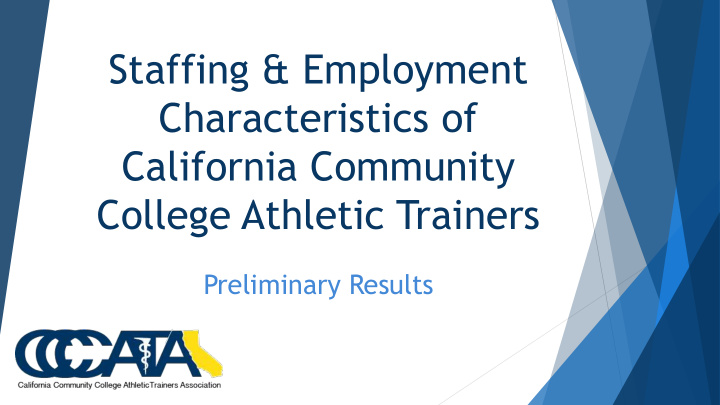



Staffing & Employment Characteristics of California Community College Athletic Trainers Preliminary Results
Presented by: Russell Muir EdD, ATC at the California Community College Athletic Trainers’ Association Southern Symposium & Business Meeting August 5, 2016 San Diego Mesa College
Background The challenges in providing a wide range of health care services to student-athletes participating in intercollegiate athletics have become more complex as colleges add more teams, more games (traditional and non-traditional seasons) and more training sessions. These increases, without proportionate staffing adjustments, may increase the risk of injury due to increased athlete exposure. This effect may expose colleges to increased legal liability.
Background According to the National Athletic Trainers’ Association (NATA) “Recommendations and Guidelines for Appropriate Medical Coverage of Intercollegiate Athletics” (AMCIA) (2007), “Sports -related lawsuits have shifted away from equipment manufacturers and their “duty to warn” toward the health care delivery process. Universities are sued over whether they have properly trained health care professionals, whether they have enough of them, whether they keep proper records, and whether they deliver proper treatment as a result” (p. 3).
Purpose Due to the locally governed nature of California’s community college system, how athletic training is handled at each institution often varies. The purpose of this survey was to quantify several variables related to labor practices, employee contracts, union representation and medical coverage.
Methodology With input from the executive board and several former and current community college athletic trainers, a survey was created using SurveyMonkey.com. Using the CCCATA member directory and individual college staff directories, the survey was emailed to athletic trainers representing all 105 community colleges that host intercollegiate athletics. Responses were received from 100 colleges (one incomplete), a completed response rate of 94.3%.
Results Overview Number of full-time athletic trainers and distribution of contract length Distribution of full-time and part-time staff Average number of sports per college Union representation Medical coverage
Contracted Months per Year for Full- Q: How Many Full-Time Athletic Time Athletic Trainers Trainers does your college employ? 3 0 (0.00%) 6 1 (3.03%) (6.06%) (0.72%) 0 (0.00%) 0 (0.00%) 23 1 (16.55%) 0 (0.72%) 27 (19.42%) 1 12 37 11 (37.37%) 2 10 53 9 87 (53.54%) 3 (62.59%) 8 7 6 5 *A follow-up survey for part-time athletic trainers is currently being conducted
Athletic Colleges with Training Colleges Sports Offered Football Staff FT PT N % Min Max Avg SD N % 3 0 3 3.03 15 20 17.67 2.517 3 100 2 2 2 2.02 21 21 21 0.000 2 100 2 1 10 10.10 10 25 17.90 4.280 9 90 2 0 25 25.25 10 23 15.76 3.358 22 88 1 2 5 5.05 12 23 16.80 4.658 5 100 1 1 19 19.19 7 17 11.89 2.846 14 73.7 1 0 29 29.29 3 21 8.79 4.212 11 37.9 0 3 1 1.01 2 2 2 0.000 0 0 0 1 5 5.05 2 11 5.80 3.899 0 0 Total 99 100 2 25 12.74 5.368 66 66.7
Average Number of Sports per Athletic Training Profile 25 21 20 17.9 17.67 16.8 15.76 15 Sports 11.89 8.79 10 5.8 5 2 0 (3-0) (2-2) (2-1) (2-0) (1-2) (1-1) (1-0) (0-3) (0-1) Avg 17.67 21 17.9 15.76 16.8 11.89 8.79 2 5.8 Athletic Trainers (FT-PT)
Q: Are non-faculty Certified Full-Time Union Representaion Athletic Trainers able to teach courses at your college? 5.04% 1.44% 0.72% 0.00% 10.07% Classified 17.17% Faculty Yes Management Union 40.40% No Management Non-Union Other Unrepresented 42.42% 82.73% Unsure
Medical Coverage Q: Must an ATC be present in order Q: Does your college allow teams to for your teams to practice? practice on the weekends? 11 (11.11%) 38 Yes Yes (38.38%) 61 No No (61.62%) 88 (88.89%)
Medical Coverage Based on injury rate Medical Response Within 3-5 Minutes and catastrophic 83 1 Volleyball W injury rate, the AMCIA 5 7 recommends an 20 1 Volleyball M 0 athletic trainer be 68 78 minimally able to 6 Soccer W 3 9 respond within 3-5 66 4 Soccer M minutes for these 3 20 sports. 82 1 Basketball W 7 8 Though being present 0 10 20 30 40 50 60 70 80 90 is optimal. Yes No Occasionally Not Offered
Medical Coverage According to the AMCIA Certified Athletic Trainers Present at Practice guidelines, wrestling, Venue football and men’s 7 basketball are 12 Wrestling 3 considered high risk 68 based on injury rate and 60 2 catastrophic injury rate. Football 5 27 26 48 Recommend an athletic Basketball M 17 7 trainer be present at all practices/competitions. 0 10 20 30 40 50 60 70 80 Yes No Occasionally Not Offered
Discussion The National Collegiate Athletic Association’s (NCAA) Sports Medicine Handbook recommends the use of the NATA’s AMCIA in determining appropriate medical staffing levels for intercollegiate athletics. The AMCIA states: “It is reasonable that one certified athletic trainer can only manage so much in a given academic year (i.e., ~one sport/season)” (p. 7). “…the assumption that full -time health care staff are able to care for two high risk sport teams in a given year (providing no significant overlap in seasons exists)” (p. 10). “A certified athletic trainer must directly supervise all full - service athletic training facilities during institution-declared hours of service” (p. 13).
Discussion Currently, the California Community College Athletic Association (CCCAA) has not addressed athletic training staffing recommendations. Due to the locally governed nature of California’s community colleges, access to medical services for student athletes may differ from college to college and may also vary from sport to sport, creating unjust inequities. More research is necessary.
Recommend
More recommend